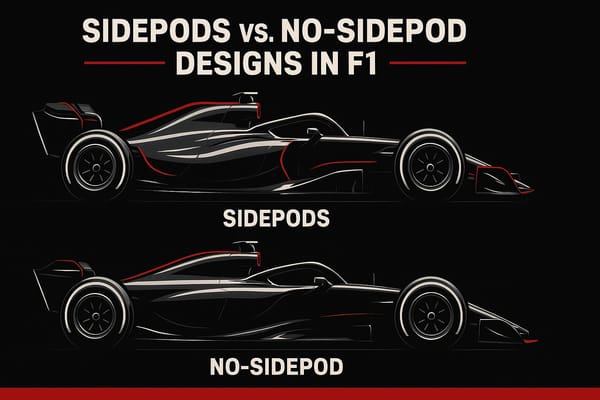How Budget Caps Reshape F1 Sponsorships
Explore how budget caps are reshaping sponsorship strategies in Formula 1, creating new opportunities and challenges for teams and brands alike.

Formula 1’s budget caps have transformed sponsorships. Introduced in 2021, these financial limits aimed to reduce spending disparities between teams and create a more balanced competition. Teams like Mercedes once spent over $400 million annually, compared to smaller teams operating on less than $150 million. Now, spending is capped at approximately $153 million for most performance-related expenses, excluding driver salaries, executive pay, and marketing.
Here’s how sponsorships have changed:
- Pre-Budget Caps: Bigger budgets meant more reliance on massive cash sponsorships, favoring wealthier teams. Smaller sponsors often struggled to compete.
- Post-Budget Caps: Teams now prioritize deals combining financial support with in-kind contributions (e.g., technical resources). This shift has opened opportunities for smaller brands, startups, and niche companies to join F1.
The cap has also introduced more predictable returns for sponsors, encouraging longer-term partnerships. However, it limits the scope for technical innovation and requires more complex deal structures to navigate spending rules.
Looking ahead, the cap will increase to $215 million in 2026 to account for new regulations and costs. As a result, sponsorship strategies will continue evolving, emphasizing partnerships that deliver value while staying within financial constraints.
1. Sponsorship Models Before Budget Caps
Sponsorship Categories
Before the introduction of budget caps, Formula 1 teams relied on a tiered sponsorship system that reflected their financial standing. There were three main categories: title, technical, and associate sponsorships. Title sponsors had their brands directly tied to the team’s identity, often becoming a key part of the team’s name. Technical sponsors, on the other hand, provided both financial backing and products, using the platform to highlight their innovations. Lastly, associate sponsors filled the remaining spaces on cars and team gear, giving companies a chance to connect with F1’s massive global audience. This structured approach allowed teams to secure deals of varying sizes, forming the backbone of their financial strategies.
Deal Sizes
In the days before budget caps, sponsorship deals came in all shapes and sizes, depending largely on the team’s reputation and success. Top-tier teams landed massive, high-value agreements, which allowed them to pour significant resources into car development and other performance-enhancing programs. Meanwhile, mid-tier teams had to settle for smaller deals, which often limited their ability to compete at the same level. This financial disparity played a major role in shaping the competitive landscape of the sport.
Team Financial Strategies
Teams were relentless in their pursuit of sponsorship dollars, knowing that every penny could make a difference on the track. Leading teams often built a diverse portfolio of long-term sponsorships to ensure steady funding. Smaller teams, however, leaned heavily on short-term deals to meet immediate financial needs, often sacrificing stability for quick cash infusions.
Sponsor Stability
The lack of spending limits also influenced the stability of sponsorship agreements. Success on the track was often directly linked to a team’s ability to secure long-term, reliable sponsors. Companies wanted quick returns and were more likely to partner with teams delivering strong results. On the flip side, teams that struggled on the track faced frequent sponsor turnover and shorter contract durations. This created a cycle where successful teams attracted premium, stable sponsorships, while underperforming ones were stuck scrambling for consistent funding. Looking back at these pre-budget cap models helps highlight the shifts in sponsorship strategies that teams have had to adopt in the post-cap era.
F1's $135 Million Game Changer: Inside the Cost Cap Revolution
2. Sponsorship Models After Budget Caps
The introduction of the $145 million budget cap in 2021 changed the game for Formula 1 teams, pushing them to rethink how they balance financial input with technical support. This has reshaped sponsorship strategies, leading to new ways of categorizing and structuring deals.
Sponsorship Categories
Gone are the days of clear-cut distinctions between cash sponsorships and technical partnerships. With the budget cap in place, teams now favor partnerships that combine financial backing with in-kind contributions that don't fall under the cap's restrictions. This hybrid approach allows teams to stretch their resources without breaking the rules.
Deal Sizes
Sponsorship deals today often feature smaller cash components paired with significant in-kind contributions. This not only helps teams manage costs more effectively but also creates opportunities for smaller teams to secure creative, value-driven arrangements.
Team Financial Strategies
Teams are adapting their financial strategies to align with these new sponsorship structures. The focus is on building long-term partnerships that combine funding with technical collaboration. At the same time, teams are enhancing sponsor activation efforts - leveraging marketing and fan engagement initiatives to offer more value to their partners.
Sponsor Stability
The budget cap has brought a more balanced approach to spending, leading to predictable returns for sponsors. This stability encourages longer-term agreements and makes Formula 1 sponsorships more appealing and reliable compared to the unpredictable landscape of the past.
Advantages and Disadvantages
The introduction of budget caps in Formula 1 has brought about a fundamental shift in sponsorship dynamics, presenting both benefits and challenges. By examining how sponsorship models have evolved over time, we can better understand the changing financial landscape of the sport.
Pre-Budget Cap Era: When Spending Was King
Before budget caps, Formula 1 teams operated with virtually no spending limits, allowing them to pour vast amounts of money into performance enhancements. This era was a playground for major corporations willing to invest heavily in exchange for immediate competitive advantages. The direct link between financial investment and on-track success made sponsorship highly appealing to large, well-funded companies.
However, this model wasn't without its drawbacks. Smaller sponsors often found themselves sidelined, as the financial "arms race" created an environment where only the wealthiest corporations could secure significant partnerships. Mid-sized companies struggled to compete, leaving sponsorship opportunities largely dominated by industry giants.
Post-Budget Cap Benefits: A More Inclusive Playing Field
The budget cap has leveled the sponsorship playing field, making Formula 1 more accessible to a wider range of companies. With spending limits in place, smaller businesses - such as tech startups, regional brands, and niche service providers - can now engage in partnerships that were once out of reach. Teams can no longer rely solely on outspending rivals, which has opened the door for innovative collaborations.
Another key benefit is financial predictability. Sponsors now have a clearer understanding of potential returns on their investments, as teams operate within defined financial parameters. This stability has made sponsorship agreements more attractive to a broader range of businesses.
The Challenges: Creativity Meets Constraints
Despite its benefits, the budget cap system has introduced some challenges. For one, the restrictions on spending have limited the scope of technical innovation. Sponsors who once used Formula 1 as a platform to showcase cutting-edge engineering may now find fewer opportunities to highlight their technological prowess.
Additionally, sponsorship agreements have grown more complex. Teams and sponsors must carefully navigate which expenses fall within the budget cap, often requiring detailed legal and administrative oversight. This added layer of complexity can be especially burdensome for sponsors accustomed to simpler, cash-for-exposure deals.
A Quick Comparison of Sponsorship Models
Here’s a snapshot of how the pre- and post-budget cap eras stack up:
| Aspect | Pre-Budget Cap | Post-Budget Cap |
|---|---|---|
| Sponsorship Access | Dominated by large corporations | Open to businesses of all sizes |
| Financial Predictability | High risk, uncertain returns | Greater stability and foresight |
| Innovation Showcase | Unlimited technical development | Innovation within spending limits |
| Deal Simplicity | Simple cash-for-exposure deals | More intricate hybrid agreements |
| Competitive Balance | Favored wealthier teams | Promotes a more even playing field |
| Long-Term Stability | Unpredictable commitments | Encourages multi-year partnerships |
This evolution in sponsorship models has changed the game for both teams and sponsors. While the budget cap has made Formula 1 more inclusive and financially stable, it has also introduced new challenges that require creative solutions. These changes continue to influence how teams plan their finances and how sponsors approach partnerships in this ever-evolving sport.
Conclusion
Budget caps have reshaped the world of F1 sponsorships, opening the doors to a broader range of participants. What was once dominated by corporate giants now includes tech startups, regional brands, and mid-sized companies competing alongside industry leaders.
Teams have shifted their focus toward long-term, hybrid partnerships that deliver value while staying within financial limits. These strategies are not just about the present - they're laying the groundwork for the next wave of regulatory changes.
For sponsors, this new model offers more predictable returns on investment, making multi-year commitments less risky. However, with massive financial injections no longer guaranteeing instant performance gains, sponsors need to adopt a more patient and strategic approach.
Looking ahead, upcoming technical regulations - like new power unit specifications and aerodynamic rules - could open the door for technology firms and automotive suppliers to shine. Teams may also need to collaborate with specialized partners in emerging technologies, further expanding the sponsorship landscape.
The budget cap era has proven that F1 can balance competitive performance with financial discipline. As teams and sponsors continue to adapt, expect to see partnerships that emphasize creativity and long-term value - setting a new standard for how professional motorsports can thrive responsibly.
FAQs
How have budget caps changed sponsorship and financial strategies for F1 teams?
The introduction of budget caps in Formula 1 has significantly changed how teams manage their finances and sponsorship strategies. For smaller teams, these caps have leveled the playing field, giving them a better chance to compete by focusing on smart resource allocation. Instead of being outspent, they can now channel their funds into critical areas like aerodynamics and engine performance.
Meanwhile, larger teams such as Mercedes and Ferrari face the challenge of working within tighter financial boundaries. This has shifted their focus from relying on massive budgets to prioritizing efficiency and creative problem-solving. Sponsorship strategies have also evolved, with teams now seeking partners that align with their refined financial plans and forward-thinking objectives. Ultimately, the budget caps are designed to foster a more competitive and equitable environment in Formula 1.
What challenges do sponsors face under F1's budget cap system?
Sponsors in Formula One are navigating a new set of challenges under the budget cap system. With tighter spending limits in place, teams have less flexibility for large-scale branding efforts. This means fewer opportunities for sponsor logos to dominate race cars, team gear, or other high-visibility platforms, making it harder to achieve the same level of exposure as before.
On top of that, teams are finding creative ways to manage their budgets, like reallocating funds or taking advantage of exemptions for things like driver salaries or legal expenses. While these strategies help teams stay within the cap, they can complicate sponsorship deals. It becomes trickier for sponsors to gauge the true value of their partnerships. Adjusting to this new financial reality, sponsors may need to rethink their goals and approaches to ensure their investments still make sense in the evolving Formula One landscape.
How will the 2026 budget cap increase impact F1 sponsorships and team strategies?
The upcoming increase in Formula 1's budget cap to $215 million in 2026 is set to shake up how sponsorships work within the sport. With tighter financial restrictions, teams are expected to prioritize getting the most out of their sponsorship deals, focusing on partnerships that are both strategic and performance-oriented.
This adjustment could open doors for midfield teams. Brands looking for a solid return on investment (ROI) might find these teams attractive due to their ability to deliver results without the hefty price tags associated with top-tier teams. Moreover, teams may branch out by bringing in sponsors from a broader range of industries, inviting fresh players into the world of Formula 1. These changes aim to create a more level playing field and ensure the sport remains financially sustainable in the long run.




